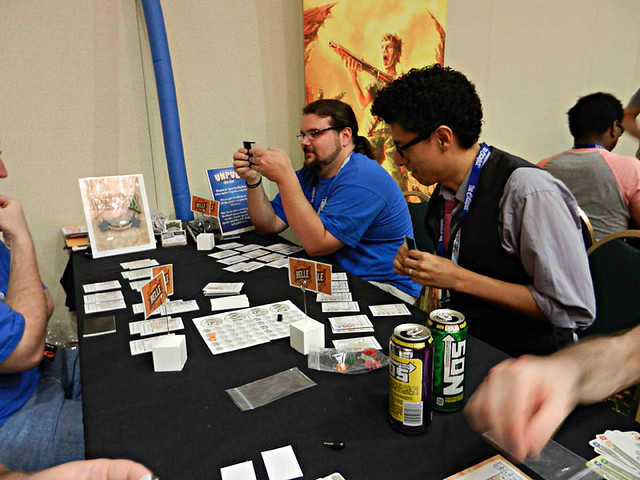
Most professional tabletop game designers I've met have a day job. This is just anecdotal, but it seems a full time game designer is VERY rare. I’m more of a pro today than I’ve ever been, but most of my household contribution still comes from an aggregate of freelance projects, Patreon, DriveThruCards, and SkillShare. Only a fraction of comes from traditional game design work. And all of that totaled together is still only about a third of what my wife makes at her normal day job.
When I'm working on any game eventually I have to ask myself the scary question:
“Is this game worth designing?”
Is this game costing me too much money? Is it costing too much time? With this series of short articles, I want to share how I figure out whether a game I'm working on is worth designing and, if so, how much I can expect to earn for my time and expense designing it. First up...
How much money has this game cost already?
The most common expense is material costs. My prototypes repurpose sticker paper or bits scrounged from a scrap store, then I endlessly recycle those materials effectively making the material costs free. If I send a prototype to a publisher and it isn’t returned, I have to note that as an expense as well.
When I intend to license my games, I use stock art, public domain art, remixed vectors, or photos to save on the art budget. All of that will usually be changed by the publisher anyway, so it doesn't make sense to spend too much on it.
If I self-publish, I allow myself a small art budget to get some custom illustrations, which significantly helps sales. Lately I make sure I have rights to include this art as part of a future licensing package to another publisher as well.
If I travel to test Game A, B, and C, then I split up my entire expense of that travel between those three games. (This includes event registration, plane tickets, food, etc.)
Let’s look at a hypothetical example: I’ve spent this much designing NOODLE KNIGHT...
- Material Costs: $50
- Shipping Costs: $50
- Art Expense: $500
- Travel Expenses: $100
So any option for publishing Game A should earn me at least $700 over its lifetime of sales. This is the unusual case where I do intend to self-publish. If I didn't, then I wouldn't have spent so much on the art budget.
How much TIME has this game cost already?
This is an easy number to quantify, but harder to justify. You can easily track how many hours you spend developing, designing, and playtesting Game A, B, and C. But when you translate that to the most minimum wage income, it’s quickly apparent that being a tabletop game designer does NOT pay a competitive hourly rate compared to other careers.
This is where the passion for the job outweighs the practical considerations. Yes, you could earn more spending those same hours doing a less satisfying job, but that just shifts costs to your emotional well-being. We’re in a fortunate and privileged position that I can decide to take a hit to my wallet rather than my happiness.
Returning to the example:
- If I've spent 50 hours developing NOODLE KNIGHT, that's about ~$360 at North Carolina minimum wage. If I want to earn at least minimum wage from my game, any publishing option should also earn an additional $360 over its lifetime of sales.
You also have to consider how much additional development time you would be willing to spend if the publisher has changes they want to make to the game. Publishers vary in their development practices. Some take the whole game and test their changes in-house without much additional input from the designer, which is great since the designer has presumably already done the vast majority of design work. Some will want changes, but expect the designer to develop them on their time, which just adds to the up-front costs you'd have to negotiate in your contract.
---
Now I have a ballpark goal of about $1060 to earn from my game. The more time or money I spend on the game, the more I'd need to earn to just break even. Beyond a certain threshold, I can't expect a retail license or POD sales to reach that number. That's why I need to keep my material costs low and development time efficient, to make any game I'm working on actually worth working on.
Any professionals out there break down their games like this? Is it too fiddly? Do you have another method of accounting? I'd love to hear it!












0 nhận xét:
Đăng nhận xét